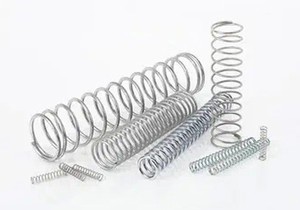Stresses in Compression Springs
Featured Product from Gardner Spring, Inc.

Stresses in Compression Springs
Compression springs, pivotal in myriad applications, are subjected to various stresses during operation. Understanding these stresses is paramount for efficient spring design, selection, and longevity. This white paper provides an overview of stresses in compression springs, shedding light on key factors, calculations, and implications.
1. Introduction
Compression springs, characterized by their ability to resist external compressive forces, are fundamental in both simple and complex mechanical systems. As these springs are compressed, the internal stresses evolve, which govern the spring's performance, durability, and potential failure points.
2. Types of Stresses in Compression Springs
2.1. Direct Shear Stress
• Description: This is the primary stress developed when a load is applied. It acts parallel to the cross-sectional area.
• Implication: Governs the fundamental performance of the spring during standard compression.
2.2. Torsional Stress
• Description: This stress arises due to the twisting motion in the coils as the spring compresses.
• Implication: A dominant factor in spring fatigue, especially in dynamic load scenarios.
2.3. Bending Stress
• Description: Develops at the inner side of the spring due to curvature. Often less dominant than shear and torsional stresses.
• Implication: Contributes to the combined stress a spring undergoes, affecting longevity.
2.4. Surging or Buckling Stress
• Description: Occurs when the spring's length is significantly larger than its diameter, causing lateral deflections or buckling.
• Implication: Can lead to premature failure if not countered with proper spring design or guide rods.
3. Key Factors Influencing Stresses
3.1. Spring Geometry: Factors like wire diameter, coil diameter, and overall length play a crucial role in determining stress distribution.
3.2. Material Properties: The modulus of rigidity, yield strength, and fatigue limits of the spring material influence how stresses are managed.
3.3. Load Type: Whether the load is static, cyclical, or dynamic has a bearing on the kind and magnitude of stresses.
3.4. Operating Environment: Temperature, corrosiveness, and other environmental factors can amplify stresses and impact spring behavior.
4. Calculating Stresses
The formula for calculating the maximum shear stress (τmax) in a helical compression spring under a load P is given by:
Where:
• d = Wire diameter
• D = Mean coil diameter
Note: This formula is a simplification, and real-world scenarios might require more intricate calculations accounting for various factors.
5. Mitigating Excessive Stresses
5.1. Appropriate Material Selection: Using materials with higher fatigue resistance can mitigate stress-related failures.
5.2. Spring Design Optimization: Adjusting parameters like coil diameter, wire diameter, and pitch can help distribute stresses effectively.
5.3. Post-Manufacturing Treatments: Processes like shot peening or stress-relieving can enhance the spring's resistance to stresses.
5.4. Environmental Considerations: Using protective coatings or selecting corrosion-resistant materials can reduce environmentally-induced stresses.
6. Conclusion
Understanding and effectively managing stresses in compression springs is imperative for ensuring their reliable performance and longevity. As the world of mechanical design evolves,
the focus on the micro-aspects of components like springs will continue to play a vital role in the broader landscape of innovation and efficiency.
References
1. Wahl, A.M. (1953). Mechanical Springs, 2nd Edition. McGraw-Hill.
2. Slocum, A. (1992). Precision Machine Design. Society of Manufacturing Engineers.
3. Juvinall, R.C., Marshek, K.M. (2000). Fundamentals of Machine Component Design.








